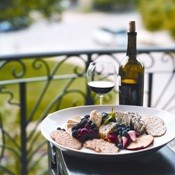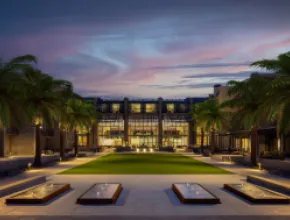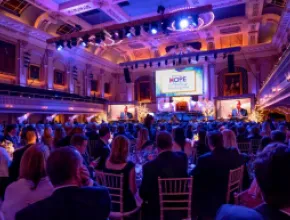There was a time when the Pacific Northwest dining scene was more geared toward satisfying a lumberjack than a gourmet. Today, however, Washington and Oregon are two of the hottest “foodie” destinations around, both known for harboring some of the country’s best wineries, microbreweries, organic farms, restaurants, food festivals and farmer’s markets.
That such a transformation should occur is only natural. After all, few regions are so blessed with all the right ingredients: abundant seafood, fertile soil, a long growing season and, perhaps most important of all, a sense of innovation and a commitment to sustainability.
“People are coming to our region because it has a reputation for its food,” says Bob Fisher, tour manager for Hometown Advantage, a DMC based in Portland. “Everything is about what we call FLOSS—fresh, local, seasonal and sustainable—and many of our restaurants and food purveyors subscribe to this ethos.”
Fisher adds that the Pacific Northwest is a leader in organic agriculture, encompassing everything from wine and produce to beef and lamb.
“We actually have more farms in Oregon now than we did in 1990—it’s the reverse trend of what’s happening nationally,” he says.
Chef Tom Douglas, winner of the James Beard Award for Best Northwest Chef and owner of several Seattle restaurants and the Pacific Ballroom, a special events venue, is similarly enthusiastic about the region’s bounty and culinary reputation.
“There’s a real sense of connection here between the farm and the table,” he says. “The chefs really support the local farmers and share the information between each other. We know that the more people support the farmer, the better our supply chain will be.”
Douglas adds that even though the Pacific Northwest has a reputation for great seafood, people from outside the region are often surprised by how seriously the locals take their fish, especially salmon.
“We think about salmon differently than people do in other parts of the country—it’s a very complex matter here,” Douglas says. “First of all, people here will never eat farm-raised salmon, only wild. Then they want to know where it came from, and was it net caught or gill caught? Our local wild salmon is a pristine and beautiful fish—and people from other regions are often surprised at how good it is.”
Edwards says he and other chefs are fortunate to have such a variety of products to draw upon, whether it’s lamb raised in Oregon’s Willamette Valley or beef from eastern Washington and Oregon.
“Although Seattle has a reputation for being a rainy city, the high-desert country is just 90 minutes east of us, and so much grows there,” he says. “Along with organic beef and lamb, there is abundant produce of all kinds—tree fruits, hops, lentils and potatoes, to name a few.”
Culinary tourism is such a growing market for the region that Travel Oregon, the state’s tourism commission, produces Oregon Bounty, a statewide promotion during October and November that encompasses everything from special events at restaurants to harvest festivals and cooking classes.
“Oregon Bounty started as a wine-tasting experience, but now it’s mushroomed to the point where we have hotels, restaurants, farmer’s markets, wineries, breweries and distilleries involved across the state,” says Michelle Godfrey, spokeswoman for Travel Oregon.
Tasteful Tours
A great way for groups to get an introduction to the depth and breadth of the Northwest food and beverage scene is through the growing number of culinary-themed tours available in Portland and Seattle. Among companies offering them is Savor Seattle Tours, which features customized food-themed programs, the most popular of which is a jaunt through Seattle’s Pike Place Market.
“In two hours you get to try over 25 different bites and sips that are quintessentially Seattle, including seasonal produce, cherry treats—Washington is the leading producer of cherries in the world—salmon and artisanal cheeses,” says Angela Shen, owner of Savor Seattle Tours. “It’s like a progressive dinner. Plus, because we have a very close relationship with the Pike Place vendors, you get an insider’s look at a very quirky icon.”
Other tours offered by the company include Gourmet Downtown, where participants sit down with chefs at various restaurants to get a behind-the-scenes look at the challenges of restaurant operation. New tours being introduced this spring include a visit to Seattle’s International District, where a wide variety of Asian restaurants can be found, and a coffee-themed tour that will include the chance to sample not only Seattle’s famous brew, but food products, including cheese and popcorn, where coffee is a key ingredient.
In Portland, Hometown Advantage offers customized food tours, including the Epicurean Excursion, a three-and-a-half-hour journey through the city’s Pearl District, where participants sample Oregon wines, beers, berry jams, cheeses, artisan breads, produce, pizza, chocolate, gelato and many more local products. Another option is the company’s Oregon Countryside Tour, an excursion outside of Portland that includes wineries, the Sake One distillery, a farmer’s market, a berry stand and more.
Native American Influences
One of the most distinctive food experiences available in the Pacific Northwest is the chance to try the wild, local salmon in much the same way that Native Americans in the region have been preparing it for centuries. Salmon prepared on cedar planks and roasted over an alderwood fire in a traditional longhouse is a featured attraction at Tillicum Village, located on an island in Puget Sound in Seattle.
Groups can also enjoy traditional salmon bakes in other venues, indoors as well as outdoors, according to Hella Coscorbi, general manager of PRA Seattle, a DMC.
“We can create an event similar to those at Tillicum Village, which is a great place, but not practical for a really large group because you can’t have 2,000 people going over to the island on a boat,” she says. “We bring in authentic entertainment and do it anywhere that holds a lot of people.”
At the Tulalip Resort Casino, which opened in August on the Tulalip Reservation 30 miles north of Seattle with a 370-room hotel and 30,000 square feet of meeting space, traditional Native American fare is a focus at one of its signature restaurants, Black Fish. Among the specialties is salmon fillet prepared on an ironwood stick roasted over an alderwood fire pit in a glassed-in area adjacent to the kitchen.
“This is how our ancestors have prepared salmon for generations, similar to how we would do it on the beach,” says Lisa Severn, food and beverage director at the resort. “We brought in tribal members to teach our culinary team how to do it We’ve taken our culture and rolled it into the restaurant.”
Other menu items include fresh, local oysters and clam fritters prepared according to a recipe from Joanne Jones, wife of Tulalip tribal leader Stan Jones. The restaurant itself has traditional touches such as long, communal tables down the center of the room where guests can dine family style.
“Most of what we serve is Northwest fare prepared with local ingredients,” Severn says. “For instance, we use berries, a traditional source of sustenance for our tribe, in many different ways. We feature a berry salsa, berry sauces for meats and desserts such as huckleberry souffle.”
Farm Fresh
Both rustic and gourmet experiences are available at scores of farms scattered throughout the Oregon and Washington countryside. Some farms offer dining experiences right on the grounds.
Among them is Summer Jo’s in Grants Pass, Ore., an organic farm with a restaurant where its own vegetables, herbs and edible flowers are the star ingredients. Another is Herbfarm near Seattle in Woodinville, Wash., where seasonal menus also draw on fresh herbs and produce grown on the premises. The restaurant, which offers two private dining rooms and can be bought out by groups of 50 to 90, serves nine-course dinners paired with five or six wine selections.
Cheese making, a growing endeavor in the Pacific Northwest, can be experienced at Juniper Grove Farm near Bend, Ore., where top-quality goat cheese is produced. Visitors can tour the farm and observe the cheese-making process.
A place to enjoy Washington’s agricultural bounty is Remlinger Farms, located about 25 miles east of Seattle in Carnation, Wash. The farm encompasses pick-it-yourself berry fields, a farmer’s market and landscaped lawn areas accommodating from 10 to 10,000 guests at events.
Wine, Beer and Spirits
Wine country is a term that seems to describe just about everywhere in the Pacific Northwest these days, with countless wineries producing several varietals, including many organic and biodynamic wines.
While Oregon’s premier wine-growing region is the Willamette Valley, where wineries are especially celebrated for pinot noir, Travel Oregon’s Godfrey notes that southern Oregon is a wine destination as well.
“Southern Oregon has warmer-weather grapes, so you will find robust reds as well as chardonnay,” she says.
In Washington, home to over 400 wineries, most of the state’s wine grapes are produced east of the Cascades, where the weather is dry and sunny. In eastern Washington, the Spokane area offers several award-winning wineries with event space, including Barrister Winery and Arbor Crest Wine Cellars.
The state’s largest concentration of wineries can be found in Woodinville, just 10 miles northeast of Seattle, including pioneers Chateau Ste. Michelle and Columbia Winery. Chateau Ste. Michelle, Washington’s oldest winery, has long been a popular wine-tasting destination and offers a variety of indoor and outdoor function spaces at an elegant 87-acre estate dating from 1912. Founded in 1962, Columbia Winery features a Victorian mansion surrounded by English gardens and offers a range of banquet rooms with fireplaces and adjoining patios.
Hot on the heels of wine production is the region’s multitude of microbreweries turning out a wide array of handcrafted beers and ales from locally grown hops. While microbreweries and brewpubs can be found throughout the Northwest, the largest concentration by far is in the Portland area, where groups can take advantage of a variety of brewery tours and tastings.
Central Oregon also has a number of notable brewing establishments, including Deschutes Brewery, which overlooks the Deschutes River in Bend and is known for flagship beers such as Mirror Pond Ale and Black Butte Porter. Groups can take tours of the Deschutes Brewery, which spotlight its state-of-the-art German brewhouse and include samples in its tasting room. Group events can be held on the third floor of the brewery in the Deschutes Mountain Room, which accommodates 80 for a sit-down function and 150 for receptions. Boasting views of the Cascade Mountains, the event facility provides full-service catering and features handcrafted brews on tap during functions.
Meanwhile, distilleries are another fast-growing entity, according to Godfrey.
“Distilleries are now where the Oregon wine scene was 20 years ago,” she says. “Out of 90 distilleries in the nation, 20 are in Oregon.”
Visits to distilleries can be arranged for groups, and some also offer event space where attendees can sample various cocktails made from the liquors produced on the premises. Among them are House Spirits, a Portland distillery that makes vodka and gin, and SakeOne, a sake distillery outside Portland in Forest Grove, Ore.
For More Info
OREGON
Ashland COC/Visitor and Convention Bureau 541.482.3486 www.ashlandchamber.com
Astoria–Warrenton Area COC 503.325.6311 www.oldoregon.com
Bay Area COC 541.266.0868 www.oregonsbayareachamber.com
Bend Visitor and Convention Bureau 541.382.8048 www.visitbend.com
Central Oregon Visitors Assn. 541.389.8799 www.visitcentraloregon.com
Clackamas County Tourism Development Council 503.655.8490 www.mthoodterritory.com
Convention and Visitors Assoc. of Lane County 541.484.5307 www.visitlanecounty.org
Corvallis Tourism 503.644.5555 www.visitcorvallis.com
CVB of Washington County 510.549.7040 www.visitwashingtoncountyoregon.com
Greater Newport COC 541.265.8801 www.newportchamber.org
Hood River County COC 541.386.2000 www.hoodriver.org
Lincoln City Visitor and Convention Bureau 541.996.1274 www.oregoncoast.org
Medford Visitors and Convention Bureau 541.779.4847 www.visitmedford.org
Ontario COC 541.889.8012 www.ontariochamber.com
Oregon Tourism Commission 503.378.8850 www.traveloregon.com
Pendleton COC 541.276.7411 www.pendletonchamber.org
Portland Oregon Visitors Association 503.275.9750 www.travelportland.com
Roseburg Visitors and Convention Bureau 541.672.9731 www.visitroseburg.com
Salem Convention and Visitors Association 503.581.4325 www.travelsalem.com
Seaside Visitors Bureau 503.738.3097 www.seasideor.com
Travel Portland 503.275.9750 www.travelportland.com
WASHINGTON
Bellevue Convention Sales Group 425.637.1020 www.bellevueconventions.com
Bellingham Whatcom County CVB 360.671.3990 www.bellingham.org
North Olympic Peninsula Visitor and CVB 360.452.8552 www.olympicpeninsula.org
Ocean Shores Convention Center 360.289.4411 www.oceanshoresmeetings.com
Olympia/Lacey/Tumwater Visitor and Convention Bureau 360.704.7544 www.visitolympia.com
San Juan Islands Visitors Bureau 360.378.3277 www.visitsanjuans.com
Seattle’s CVB 206.461.5800 www.visitseattle.org
Seattle Southside Visitor Services 206.575.2489 www.seattlesouthside.com
Snohomish County Tourism Bureau 425.348.5802 www.snohomish.org
Southwest Washington CVB 360.750.1553 www.southwestwashington.com
Spokane Regional CVB 509.624.1341 www.visitspokane.com
Tacoma Regional CVB 253.627.2836 www.traveltacoma.com
Tri-Cities Visitor and Convention Bureau 509.735.8486 www.visittri-cities.com
Washington State Tourism Department 510.549.7040 www.tourism.wa.gov
Wenatchee Valley CVB 509.663.3723 www.wenatcheevalley.org
Yakima Valley Visitors and Convention Bureau 509.575.3010 www.visityakima.com







